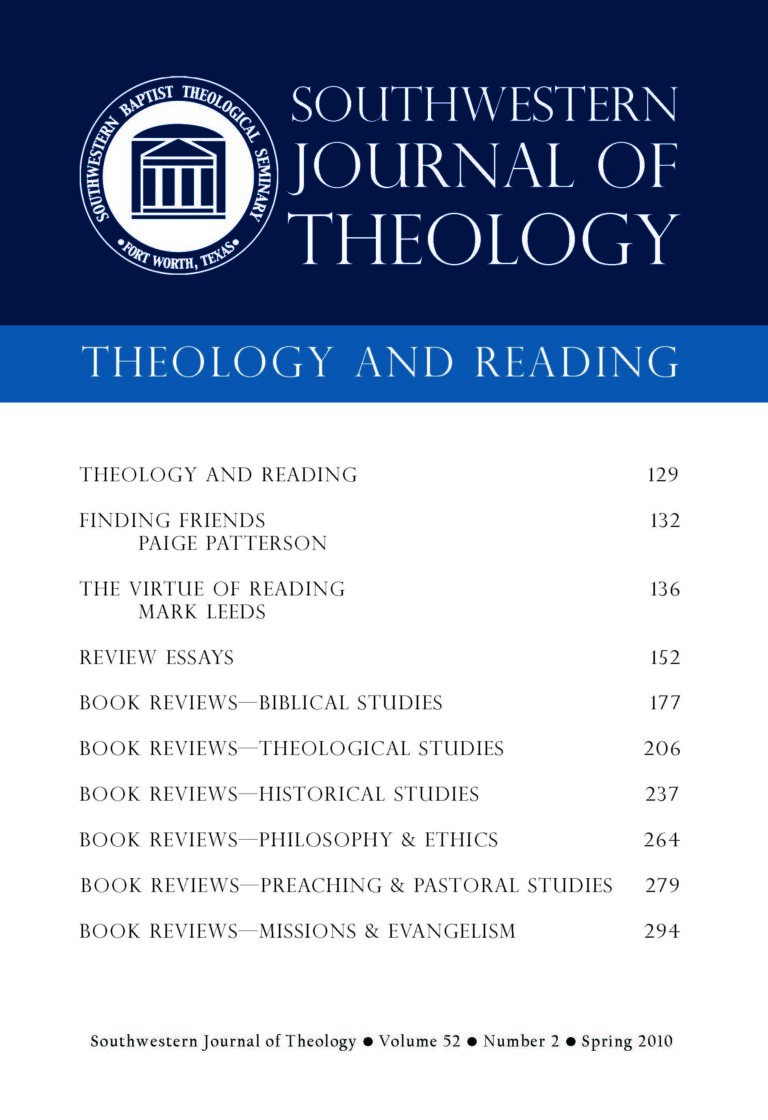
Theology and Reading
Southwestern Journal of Theology
Volume 52, No. 2 – Spring 2010
Managing Editor: Malcolm B. Yarnell III
By R.T. France. The New International Commentary on the New Testament. Grand Rapids: Eerdmans, 2007. 1,233 pages. Hardcover, $60.00.
Finally! In 1946 the New International Commentary on the New Testament (NICNT) was announced as a seventeen-year project, with the first volumes appearing in the early 1950s. This excellent series has now been around so long that totally new volumes by new scholars are replacing old volumes, such as Green’s commentary on Luke replacing Geldenhuy’s and Fee’s commentary on 1 Corinthians replacing Grosheide’s. Yet, until 2007 there was no commentary on Matthew in the NICNT, due to two other scholars attempting but not completing this project (xvi).
Some volumes in NICNT are truly outstanding, and that group will now include R.T. France’s commentary on Matthew. No newcomer to Gospel studies, France wrote the NIGTC volume on Mark, yet Matthew is his area of expertise. France wrote the Tyndale New Testament Commentary volume on Matthew in 1985. He wrote Matthew: Evangelist and Teacher in 1990 to cover the background issues that a commentary on Matthew usually covers, which explains the short introductory material in this present volume (1–22) as well as some brief introductions of major discourse material such as the Sermon on the Mount (“The Discourse on Discipleship,” 153–56) and the Olivet Discourse (“The End of the Old Order,” 889–93). Therefore, one ought to own and use the 1990 volume as a helpful companion volume to the present commentary.
This commentary is thorough, thoughtful, and insightful. It is purposefully an exegetical commentary on the text of Matthew and “not a commentary on other commentaries (xix),” thus writing in the tradition of truly significant commentaries. Yet, he does interact with the latest scholarly findings when necessary. France furnishes fresh information, such as helpful insight in contrasting modern misunderstanding of the text versus the original meaning. The translation of basileia as “kingdom” rather than “reign” can be misleading because of the wrong connotations of “kingdom” (102, footnote 24, 151, 190). Thus, “God ruling” is better than “the kingdom of God” since the subject and focus is more properly on God rather than kingdom (102). In interpreting what Jesus said about divorce in 5:31–32 and 19:3–12, it helps to know that in the traditional Jewish view of marriage that the act of porneia destroyed the marriage—not allowing it to continue, and in the case of a divorce a Jew assumed a remarriage is allowed (211–12).
Thankfully, France is sometimes open to the harmonistic solution of two actual occurrences of a sermon or event to explain both similarities and differences in Synoptic accounts of them (rather than the Evangelists altering a single event) (242, 309). Certainly Jesus could have taught similar materials on more than one occasion, giving them some variation each time, although most scholars do not opt for this solution (242).
France employs his own translation of the Greek in this commentary, which is refreshing. Yet, since France was on the committee that edited the TNIV translation, it is not surprising that he employs a gender-neutral translation in this commentary. Unfortunately, using gender-neutral language can make a less specific translation, such as changing the singular “he must deny himself ” to the plural “they must deny themselves” (16:24) or “he” to “they” in 18:15–17. Or, it can involve a grammatically-awkward singular and plural mixed sentence, as in “if anyone . . . they must” (16:24) (635). In 4:1 France uses the generic “a person” rather than “man” (125). He does discuss that his “to fish for people (4:19)” does not link well with “fishermen” in v. 18, but neither does adding “women” and “children” to “men” seem a satisfactory alternative (145). The ten wise or prudent versus foolish virgins becomes the ten silly versus sensible girls—good alliteration but strange translation (Matt 25:1–13) (932–33)!
Some readers may not care for France’s many references to such pseudepigraphical writings as the Gospel of Thomas (e.g., 159, 640, 814) or the Gospel of Peter (e.g., 1056, 1064–66), but such references are to be expected in modern Gospel studies, and France uses many more references to more helpful ancient sources, such as the writings of Josephus (e.g., 862–63, 887–88, 1048). France’s commentary benefits the pastor, student, teacher, and scholar, and this excellent volume will be a standard resource for years to come.





